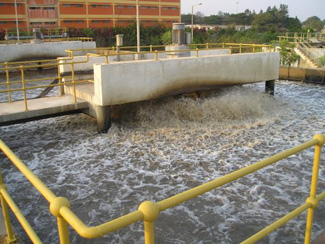In search of a new process to make more biodegradable phenolic compounds

Biological treatment of phenolic industrial effluents usually has low removal efficiency. Therefore, other technologies such as Wet Air Oxidation and Wet Peroxide Oxidation could be applied. The main objective of this research was to integrate the benefits of both techniques in an intensified process to give an effluent that could be later biologically treated.
The importance of phenolic industrial effluents, besides from their potential toxicity, is outlined by the high quantities that are eventually disposed. For instance, phenol, o-cresol and p-nitrophenol are recognised toxic substances listed in the list of high production volume chemicals by the Organisation for Economic Cooperation and Development in 2004. Besides, each year 2700 tonnes of phenolic compounds are rejected by the European countries (Figure 1), being 240 of them corresponding to Spanish wastes. Biological treatment of these compounds usually has low removal efficiency; therefore, other technologies such as Wet Air Oxidation (WAO) and Wet Peroxide Oxidation (WPO) could be applied. Both processes are suitable to generate an effluent that could later be discharged into a municipal biological Wastewater Treatment Plant (WWTP) as part of the total influent.
Figure 1. Emissions to water. Source: European Pollution Emission Register (http://eper.ec.europa.eu)
The main objective of this research was to integrate the benefits of both Catalytic WAO (with activated carbon as catalyst) and WPO in an intensified process, named here Hydrogen Peroxide Promoted Catalytic Wet Air Oxidation (PP-CWAO), to give an effluent that could be later biologically treated. Main advantages of using this promising process should be, on one hand, the decrease of conventional WAO and WPO process costs by lowering its severe reaction conditions, keeping high conversion of pollutant in industrial wastewater, and on the other hand, the use of a low cost catalyst, a non-modified activated carbon, which avoids leaching problems associated to heterogeneous processes using metal-based catalysts.
To study the feasibility of the PP-CWAO process, using activated carbon as catalyst, seventy-two hours experiments were performed at a temperature of 140 ºC and an oxygen partial pressure of 2 bar. Feed concentrations, in terms of chemical oxygen demand (COD), were 11.8 g COD l-1 for phenol, 12.6 g COD l-1 for o-cresol and 8.0 g COD l-1 for p-nitrophenol. Air was used as main oxidant and the 20% of the amount of H2O2 (hydrogen peroxide) needed for complete destruction each pollutant was added as oxidation promoter.
The results show that the addition of H2O2 to the CWAO process not only increases pollutant removal but also leads to higher mineralisation of the remaining oxidation products. For instance, removal of phenol, o-cresol and p-nitrophenol increase from 45, 33 and 15% in the CWAO process to 64, 64 and 49% in the PP-CWAO process. In addition, the PP-CWAO process leads to better biodegradability enhancements, when compared to CWAO, as demonstrated by the respirometric tests.
However, it is still necessary to improve the oxidation step in order to assure more biodegradable effluents that could be combined with a subsequent biological wastewater plant.
References
"Biodegradability enhancement of phenolic compounds by Hydrogen Peroxide Promoted Catalytic Wet Air Oxidation". Rubalcaba, Alicia; Suarez-Ojeda, Maria Eugenia; Carrera, Julian; Font, Josep; Stuber, Frank; Bengoa, Christophe; Fortuny, Agusti; Fabregat, Azael. CATALYSIS TODAY, 124 (3-4): 191-197 JUN 30 2007.


